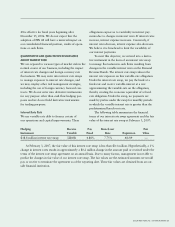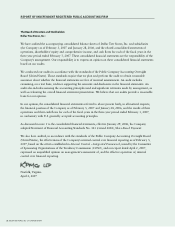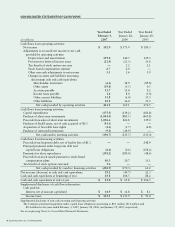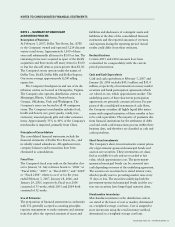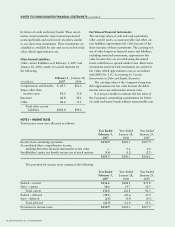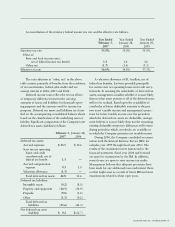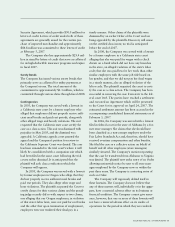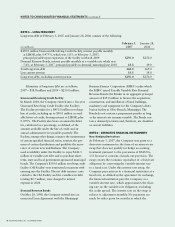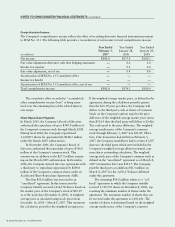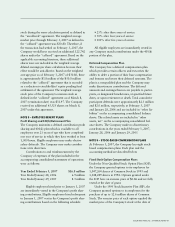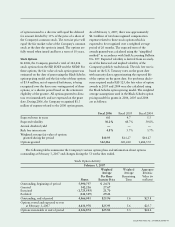Dollar Tree 2006 Annual Report Download - page 37
Download and view the complete annual report
Please find page 37 of the 2006 Dollar Tree annual report below. You can navigate through the pages in the report by either clicking on the pages listed below, or by using the keyword search tool below to find specific information within the annual report.
Net Income Per Share
Basic net income per share has been computed by
dividing net income by the weighted average number
of shares outstanding. Diluted net income per share
reflects the potential dilution that could occur assum-
ing the inclusion of dilutive potential shares and has
been computed by dividing net income by the weight-
ed average number of shares and dilutive potential
shares outstanding. Dilutive potential shares include
all outstanding stock options and unvested restricted
stock, excluding certain performance based restricted
stock grants, after applying the treasury stock method.
NOTE 2 – BALANCE SHEET COMPONENTS
Intangibles, Net
Intangibles, net, as of February 3, 2007 and January
28, 2006 consist of the following:
February 3, January 28,
(in millions) 2007 2006
Non-competition agreements $ 6.4 $ 6.4
Accumulated amortization (5.1) (4.3)
Non-competition
agreements, net 1.3 2.1
Favorable lease rights 19.0 12.6
Accumulated amortization (7.0) (4.1)
Favorable lease rights, net 12.0 8.5
Goodwill 144.9 130.3
Accumulated amortization (11.6) (11.6)
Goodwill, net 133.3 118.7
Total intangibles, net $146.6 $129.3
Non-Competition Agreements
The Company has entered into non-competition
agreements with certain former executives of certain
acquired entities. These assets are being amortized
over the legal term of the individual agreements,
ranging from five to ten years.
Favorable Lease Rights
In 2006 and 2005, the Company acquired favorable
lease rights for operating leases for retail locations
from third parties, including the acquired favorable
lease rights in its acquisition of 138 Deal$ stores (see
Note 10). The Company’s favorable lease rights are
amortized on a straight-line basis to rent expense
over the remaining initial lease terms, which expire
DOLLAR TREE STORES, INC. • 2006 ANNUAL REPORT 35
at various dates through 2016. The weighted average
life remaining on the favorable lease rights at
February 3, 2007 is 54 months.
Amortization expense related to the non-com-
petition agreements and favorable lease rights was
$4.4 million, $3.3 million and $1.6 million for the
years ended February 3, 2007, January 28, 2006 and
January 29, 2005, respectively. Estimated annual
amortization expense for the next five years follows:
2007 – $4.8 million; 2008 – $3.4 million; 2009 –
$1.8 million, 2010 – $1.2 million, and 2011 –
$0.7 million.
Goodwill
In accordance with SFAS No. 142, goodwill is no
longer being amortized, but is tested annually for
impairment. In addition, goodwill will be tested on an
interim basis if an event or circumstance indicates that
it is more likely than not that an impairment loss has
been incurred. The Company performed its annual
impairment testing in November 2006 and deter-
mined that no impairment loss existed.
Property, Plant and Equipment, Net
Property, plant and equipment, net, as of February 3,
2007 and January 28, 2006 consists of the following:
February 3, January 28,
(in millions) 2007 2006
Land $ 29.4 $ 29.4
Buildings 154.7 154.7
Improvements 482.3 418.1
Furniture, fixtures and
equipment 708.6 608.4
Construction in progress 38.3 29.3
Total property, plant
and equipment 1,413.3 1,239.9
Less: accumulated
depreciation and
amortization 698.0 558.1
Total property, plant
and equipment, net $ 715.3 $ 681.8
Other Assets, Net
Other assets, net includes $39.2 million of restricted
investments. The Company purchased these restricted
investments to collateralize long-term insurance obli-
gations. These investments replaced higher cost stand


